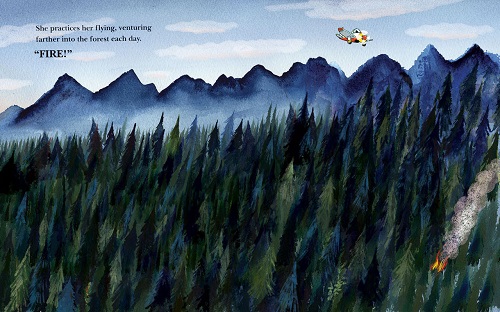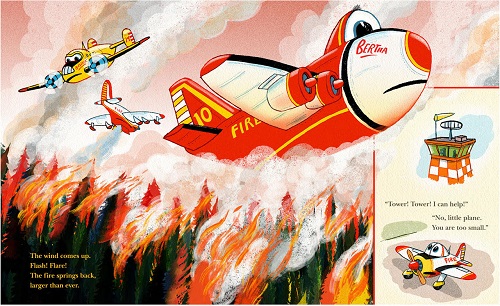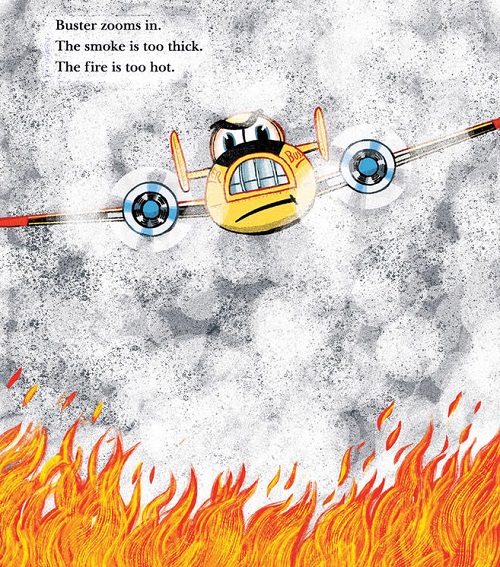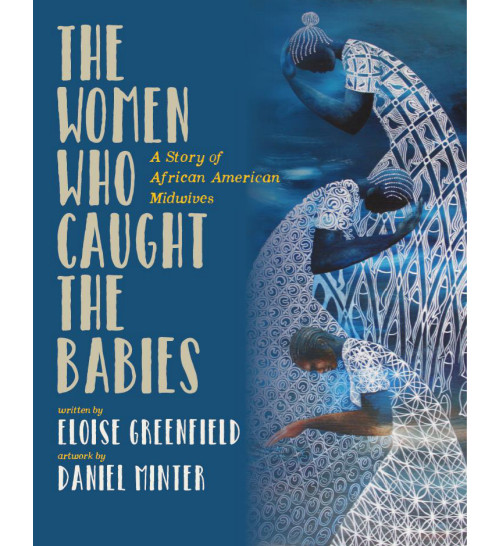
By Jules

There’s been a long history of anthropomorphic vehicles in children’s books and in children’s entertainment — from Little Toot and Pedro to Cars. Robert Neubecker’s Little Smokey (Knopf, August 2019) provides a modern twist with an environmental edge, given the frequency of forest fires in this country.
 Everyone has a job at the Nif-C, or National Interagency Fire Center. There’s Buster the air tanker, who sprays water on forest fires; Bruno the water scooper, who retrieves water from rivers and lakes for attacking flames; and Bertha the Very Large Air Tanker, who carries fire retardant. The hero of the book’s title starts the story without a name, because at Nif-C, “you have to earn your name.” When the summer gets hot and “the country grows dry,” the planes take off with a giant roar. The little plane is told she can’t help, but she practices her flying nonetheless. When a fire spreads into a canyon yet the big planes are unable to attack it, the little plane begs: “I can fly fast! I can fly low! I can help! Please let me go!” Indeed, she’s small enough to pour water down in just the right place, allowing the bigger planes to soar in and wrap things up. The little plane flies back, feeling triumphant and covered in smoke — and is dubbed, finally, Little Smokey.
Everyone has a job at the Nif-C, or National Interagency Fire Center. There’s Buster the air tanker, who sprays water on forest fires; Bruno the water scooper, who retrieves water from rivers and lakes for attacking flames; and Bertha the Very Large Air Tanker, who carries fire retardant. The hero of the book’s title starts the story without a name, because at Nif-C, “you have to earn your name.” When the summer gets hot and “the country grows dry,” the planes take off with a giant roar. The little plane is told she can’t help, but she practices her flying nonetheless. When a fire spreads into a canyon yet the big planes are unable to attack it, the little plane begs: “I can fly fast! I can fly low! I can help! Please let me go!” Indeed, she’s small enough to pour water down in just the right place, allowing the bigger planes to soar in and wrap things up. The little plane flies back, feeling triumphant and covered in smoke — and is dubbed, finally, Little Smokey.
Neubecker’s landscapes-afire spreads are breathtaking and dramatic. There is an almost inevitably retro look to these illustrations featuring animated planes, but Neubecker also keeps things modern with a diverse cast of humans on the runways, as well as female mechanics. But the determined planes are the real stars of the show, and children will root for the little plane that could. In the spread where she finally gets to fly to the blazing fires, we even see what looks like her tongue stuck out to the side in concentration. (That is pictured below.) I love it.
Appended is information about how wildfires start; who fights them; what the reader can do to help avoid them; and more. Here are some spreads so that Neubecker’s art can do the talking.

‘Bertha is the biggest plane…’ (Click to enlarge spread and read text in its entirety)

‘She practices her flying, venturing farther into the forest each day…’ (Click to enlarge spread and read text in its entirety)

‘The wind comes up. Flash! Flare!…’ (Click to enlarge spread and read text in its entirety)


Click first image to see spread in its entirety


Click either image to see the spread in its entirety

‘The little plan pours water down, down…’ (click to enlarge spread and read text in its entirety)
LITTLE SMOKEY. Copyright © 2019 by Robert Neubecker. Illustrations reproduced by permission of the publisher, Alfred A. Knopf, New York.
***
The Midwife Experience: A Personal Perspective
“Midwives have been in the world probably as long as there have been human babies on earth.” Thus opens The Women Who Caught the Babies, a picture book by the legendary Eloise Greenfield, coming to shelves in September (Alazar Press) and illustrated by Daniel Minter. A five-page introduction kicks things off and is followed by a series of poems that follows African American midwives from slavery to the early 2000s. The book closes with a poem about the midwife who caught Greenfield herself, as well as some family photos.

‘They caught the babies,/and catch them still,/welcome them into the world,/for loving.’ (Click image to see spread in its entirety)

A poem called “The Women” (the one under the image at the top of this post) opens and closes this collection. In between, Greenfield’s free verse poetry captures the work of women in Africa (“before the shackles”) who caught babies; the slaves brought to America who continued the work; the women after Emancipation who caught babies “born into freedom”; and midwives of the early 1900s and 2000s. It’s a spare, short collection with unfussy, direct language; the verses capture the powerful, loving, and unwavering work of these women, who guided humans into the world “with gentle, loving hands.” The verses are accompanied by Minter’s dramatic portraits — dominated by rich shades of blue — of women and babies, though one features a black man holding his “first child born into freedom,” and they are filled with symbolic patterns and images.
I’ve a few spreads here today to show you. (If you didn’t see Minter’s illustrations in Kelly Starling Lyons’s Going Down Home with Daddy, be sure to head here. It’s one of my favorite picture books this year.)

‘Somewhere in the African past,/before the guns, before the/shackles …’ (Click image to read text in its entirety

‘ … She would have to leave quickly./The baby would not wait./She had already packed her things,/her stethoscope, her scales/for weighing the baby, and /everything she would need.’ (Click image to read text in its entirety)

‘Her cell phone rings. ‘Hurry!’/the caller says, when the woman/answers. …’ (Click image to read text in its entirety)
THE WOMEN WHO CAUGHT THE BABIES: A STORY OF AFRICAN AMERICAN MIDWIVES. Text copyright © 2019 by Eloise Greenfield. Illustrations copyright © 2019 by Daniel Minter and reproduced by permission of the publisher, Alazar Press, Carrboro, North Carolina.
 Julie Davidson (Jules) conducts interviews and features of authors and illustrators at her acclaimed blog, Seven Impossible Things Before Breakfast, a children’s literature blog primarily focused on illustration and picture books. The above blogs were posted at 7-Imp on July 28, 2019 and July 21, 2019, respectively.
Julie Davidson (Jules) conducts interviews and features of authors and illustrators at her acclaimed blog, Seven Impossible Things Before Breakfast, a children’s literature blog primarily focused on illustration and picture books. The above blogs were posted at 7-Imp on July 28, 2019 and July 21, 2019, respectively.


